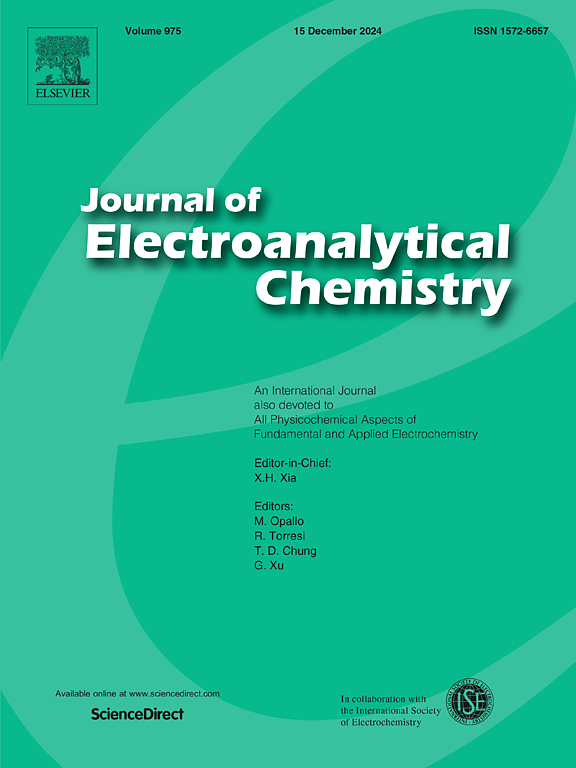聚氯乙烯-咪唑和乙烯基-二茂铁复合衍生的Fe-N-C电催化剂在阴离子交换膜燃料电池中的氧还原反应
IF 4.1
3区 化学
Q1 CHEMISTRY, ANALYTICAL
引用次数: 0
摘要
阴离子交换膜燃料电池(aemfc)采用无铂催化剂进行氧还原反应(ORR)的可行性高,是一种可持续、清洁的电化学能量转换装置。在此,我们选择了乙烯基二茂铁和乙烯基咪唑聚合物复合材料,它们具有导电和配位网络,有望用于各种电化学应用。通过x射线衍射、拉曼光谱、N2物理吸附、x射线光电子能谱和扫描透射电镜证实,所制备的催化剂材料具有丰富的orr活性中心,具有高比表面积、孔径分布、缺陷和表面化学态等良好的物理化学性质。通过优化乙烯基二茂铁和乙烯基咪唑的不同配比以及硝酸锌处理,获得了在0.1 M KOH电解液中高效电催化ORR活性的突出结构性能,半波电位为0.80-0.85 V / RHE,与Pt/C基准相当。其中,fnc - t2表现出较高的ORR活性。这与电催化剂的高活性Fe-Nx位点和分层多孔结构有关。由于RDE研究中优异的电化学稳定性和AEMFC的高功率密度(344 mW cm - 2),这项工作对开发AEMFC阴极的高效电催化剂产生了重大影响。本文章由计算机程序翻译,如有差异,请以英文原文为准。

Polyvinyl-imidazole and vinyl-ferrocene composite-derived Fe-N-C electrocatalysts for oxygen reduction reaction in anion exchange membrane fuel cells
Anion exchange membrane fuel cells (AEMFCs) are sustainable and clean electrochemical energy conversion devices due to their high feasibility of employing platinum-free catalysts for oxygen reduction reaction (ORR). Herein, we selected vinylferrocene and vinylimidazole polymer composite with their conductive and coordination networks anticipated for their diverse electrochemical applications. The prepared catalyst materials possess highly abundant ORR-active centers and favourable physico-chemical properties like high specific surface area, pore size distribution, defects and surface chemical states, which are confirmed by X-ray diffraction, Raman spectroscopy, N2 physisorption, X-ray photoelectron spectroscopy and scanning transmission electron microscopy. The catalyst materials are assessed through optimization of different ratios of vinylferrocene and vinylimidazole along with zinc nitrate treatment to attain the prominent textural properties for efficient electrocatalytic ORR activity in 0.1 M KOH electrolyte and the half-wave potential is 0.80–0.85 V vs. RHE, which is comparable to that of the Pt/C benchmark. Amongst, FerNC-T2 shows higher ORR activity than other prepared catalysts. This is accredited to the highly active Fe-Nx sites and hierarchical porous structure of the electrocatalyst. This work made a significant impact in developing efficient electrocatalysts for AEMFC cathodes owing to the excellent electrochemical stability in RDE study and high-power density in an AEMFC (344 mW cm−2).
求助全文
通过发布文献求助,成功后即可免费获取论文全文。
去求助
来源期刊
CiteScore
7.80
自引率
6.70%
发文量
912
审稿时长
2.4 months
期刊介绍:
The Journal of Electroanalytical Chemistry is the foremost international journal devoted to the interdisciplinary subject of electrochemistry in all its aspects, theoretical as well as applied.
Electrochemistry is a wide ranging area that is in a state of continuous evolution. Rather than compiling a long list of topics covered by the Journal, the editors would like to draw particular attention to the key issues of novelty, topicality and quality. Papers should present new and interesting electrochemical science in a way that is accessible to the reader. The presentation and discussion should be at a level that is consistent with the international status of the Journal. Reports describing the application of well-established techniques to problems that are essentially technical will not be accepted. Similarly, papers that report observations but fail to provide adequate interpretation will be rejected by the Editors. Papers dealing with technical electrochemistry should be submitted to other specialist journals unless the authors can show that their work provides substantially new insights into electrochemical processes.

 求助内容:
求助内容: 应助结果提醒方式:
应助结果提醒方式:


